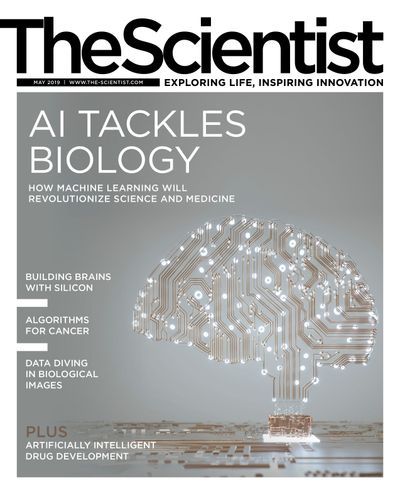Login
SubscribeFeatures

AI Uses Images and Omics to Decode Cancer
Amber Dance | May 1, 2019 | 10 min read
Machine learning can analyze photographs of cancer, tumor pathology slides, and genomes. Now, scientists are poised to integrate that information into cancer uber-models.
Building a Silicon Brain
Sandeep Ravindran | May 1, 2019 | 10+ min read
Computer chips based on biological neurons may help simulate larger and more-complex brain models.

Artificial Intelligence Sees More in Microscopy than Humans Do
Jef Akst | May 1, 2019 | 8 min read
Deep learning approaches in development by big players in the tech industry can be used by biologists to extract more information from the images they create.

Artificial Intelligence Tackles a World of Images
Carolyn Wilke | May 1, 2019 | 5 min read
With the help of computer algorithms that excel at pattern recognition, researchers look for meaning in vast pictorial datasets.
Contributors
Contributors
Contributors
Meet some of the people featured in the May 2019 issue of The Scientist.
Editorial
Cerebral Inception
Cerebral Inception
Our brains have evolved to the point where we can build artificial brains that might help us understand our brains. Let that sink in.
Speaking of Science
Ten Minute Sabbatical
Ten Minute Sabbatical
Take a break from the bench to puzzle and peruse.
Notebook
Artificially Intelligent Tools Capture Animal Movement
Artificially Intelligent Tools Capture Animal Movement
Algorithms for motion capture help neuroscientists dig into the question of how the brain produces behavior.
Computers Extract Disease Clues from Speech
Computers Extract Disease Clues from Speech
AI models can pick up subtle alterations in linguistic and vocal attributes of spoken language that may be indicative of failing health.
Artificial Intelligence Could Help Monitor Bee Health
Artificial Intelligence Could Help Monitor Bee Health
A high school student designs a new beehive and gets help from machine learning to monitor for varroa mite infestation.
Deep Learning Algorithms Identify Structures in Living Cells
Deep Learning Algorithms Identify Structures in Living Cells
Researchers are using artificial intelligence to pick out the features of brightfield microscopy images.
Modus Operandi
Microbiology Meets Machine Learning
Microbiology Meets Machine Learning
Artificially intelligent software has human-like ability to analyze host-pathogen interactions in microscopy images.
Critic at Large
Opinion: AI Beats Animal Testing at Finding Toxic Chemicals
Opinion: AI Beats Animal Testing at Finding Toxic Chemicals
Machine learning could be the key to reducing the use of animals in experiments.
The Basics
A Primer: Artificial Intelligence Versus Neural Networks
A Primer: Artificial Intelligence Versus Neural Networks
A brief history of AI, machine learning, artificial neural networks, and deep learning.
The Literature
Could AI Make Gene Editing More Accurate?
Could AI Make Gene Editing More Accurate?
Machine learning algorithms predict the repairs made to DNA after Cas9 cuts.
Computational Tools Sort Signal from Noise
Computational Tools Sort Signal from Noise
Researchers are developing computational approaches to extract information from multiple sets of single-cell sequencing data.
Profile
Robert Murphy Bets Self-Driving Instruments Will Crack Biology’s Mysteries
Robert Murphy Bets Self-Driving Instruments Will Crack Biology’s Mysteries
The Carnegie Mellon computational biologist thinks machine learning algorithms can direct high-throughput experiments to solve the field’s unanswered questions.
Scientist to Watch
Nick Turk-Browne Explores the Neuroscience of Learning
Nick Turk-Browne Explores the Neuroscience of Learning
The Yale University cognitive neuroscientist studies how the brain extracts patterns from experiences.
Lab Tools
Using Machine Learning to Battle Antibiotic Resistance
Using Machine Learning to Battle Antibiotic Resistance
Researchers are using artificial intelligence to identify known and novel resistance genes.
Bio Business
Artificial Intelligence Shakes Up Drug Discovery
Artificial Intelligence Shakes Up Drug Discovery
The pharmaceutical industry is looking to machine learning to overcome complex challenges in drug development.
Reading Frames
Can Artificial Intelligence Make Scientific Discoveries?
Can Artificial Intelligence Make Scientific Discoveries?
The author of a new book envisions a future when machines advance the research enterprise.
Foundations
Machine, Learning, 1951
Machine, Learning, 1951
Marvin Minsky engineered the first known artificial neural network, in which “rats” represented as lights learned to solve a maze.
Infographics
Infographic: How AI Analyzes Cancer
Infographic: How AI Analyzes Cancer
The latest machine learning models can identify many visual and molecular features of a particular cancer. If the technology advances to the clinic, it could help diagnose patients and predict survival.
Infographic: Brain-Like Computers Provide More Computer Power
Infographic: Brain-Like Computers Provide More Computer Power
Neuromorphic technology is fueling fast, large-scale simulations, supporting researchers’ endeavors to build models of the human brain.
Infographic: Human-Style Image Analysis Without the Human
Infographic: Human-Style Image Analysis Without the Human
Artificially intelligent software has human-like ability to analyze host-pathogen interactions in microscopy images.
Infographic: AI Predicts Post-CRISPR Repairs
Infographic: AI Predicts Post-CRISPR Repairs
Double-strand breaks can produce several different outcomes.






















